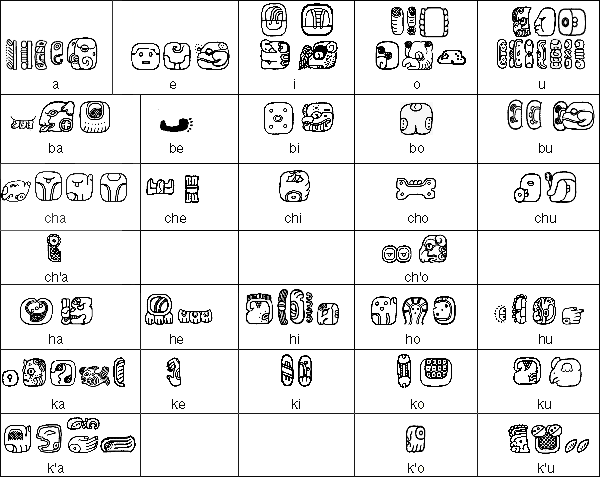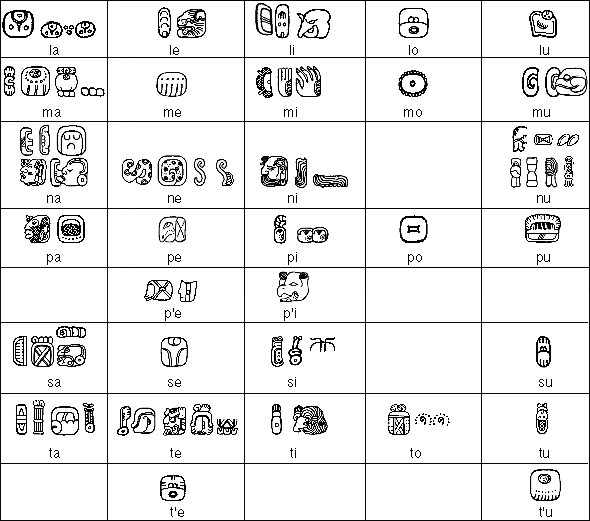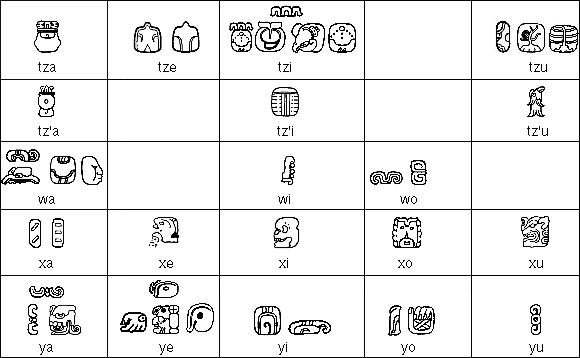 Mayan script
Mayan script
The Mayan civilisation lasted from about 500 BC to 1200 AD, with a classical period from 300-900 AD. The earliest known writing in the Mayan script dates from about 250 BC, but the script is thought to have developed at an earlier date. Recent archeological finds indicate that the Mayan civilisation started much earlier: around 3,000 BC.
In about 1566, the first bishop of Yucatan, Diego de Landa, compiled a key to the Mayan syllabary consisting of 27 Spanish letters and the Mayan glyphs with similar sounds. This became known as the Landa Alphabet and helped with the decipherment of the script, even though it was based on the false premise that the script was alphabetic.
For a long time many scholars believed that the script did not represent a language at all, or that it wasn't a complete writing system. The first major breakthrough in decipherment came during the 1950s when a Russian ethnologist, Yuri Valentinovich Knorosov, proposed that the Mayan script was at least partly phonetic and represented the Yucatec Mayan language. His ideas were not welcomed by other Mayanists, but he was eventually proved correct.
Further progress in the decipherment was made during the 1970s and 1980s when more linguistics began to take an interest in the script. Today most Mayan texts can be read, though there are still some unknown glyphs.
A gripping account of the decipherment of the Mayan script can be found in Breaking the Maya Code, by Micheal D. Coe.
The Yucatec Maya continued to use the Mayan script until at least the 16th century. Recently, their descendants have started to learn the script once again from the scholars who have deciphered it.



Some Mayan logograms


Information about the Mayan script | Books about Mayan writing | Mayan language learning materials
Information about the Mayan script
http://en.wikipedia.org/wiki/Maya_script
https://www.bl.uk/history-of-writing/articles/ancient-maya-writing
https://www.mayaarchaeologist.co.uk/school-resources/maya-world/maya-writing-system/
Dictionary of Maya Hieroglyphs
http://www.famsi.org/mayawriting/dictionary/montgomery/
Mayan fonts
http://www.dafont.com/font.php?file=mayan
https://www.fontspace.com/category/mayan
Mayan Translator
https://www.paleoaliens.com/event/mayan_glyphs/
Foundation for the Advancement of Mesoamerican Studies
http://www.famsi.org
Mayan Civilization
http://www.crystalinks.com/mayan.html
Maya jewelry
http://www.clearlight.com/bolaman/mayaglph.htm
Achi, Akatek, Awakatek, Chontal Maya, Ch’ol, Chorti, Chuj, Huasteco, Itzaʼ, Ixil, Jakaltek, Kaqchikel, Ki'che', Lacandon, Mam, Mocho’, Mopan, Poqomam, Poqomchiʼ, Q’anjob’al, Q'eqchi', Sakapultek, Sipakapense, Tektitek, Tojolabal, Tzeltal, Tzotzil, Tz'utujil, Uspantek, Yucatec Maya
Akkadian Cuneiform, Ancient Egyptian (Demotic), Ancient Egyptian (Hieratic), Ancient Egyptian (Hieroglyphs), Chinese, Chữ-nôm, Cuneiform, Japanese, Jurchen, Khitan, Linear B, Luwian, Mayan, Naxi, Sawndip (Old Zhuang), Sui, Sumerian Cuneiform, Tangut (Hsihsia)
Page last modified: 15.03.23
[top]
Why not share this page:

If you like this site and find it useful, you can support it by making a donation via PayPal or Patreon, or by contributing in other ways. Omniglot is how I make my living.
Note: all links on this site to Amazon.com, Amazon.co.uk
and Amazon.fr
are affiliate links. This means I earn a commission if you click on any of them and buy something. So by clicking on these links you can help to support this site.
Get a 30-day Free Trial of Amazon Prime (UK)
If you're looking for home or car insurance in the UK, why not try Policy Expert?
[top]